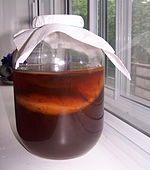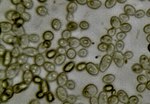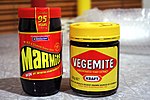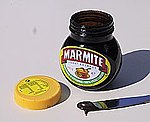Yeast
| Yeast | |
|---|---|

| |
| Saccharomyces cerevisiae, a species of yeast | |

| |
| Cross-sectional labelled diagram of a typical yeast cell | |
| Scientific classification | |
| Domain: | Eukaryota |
| Kingdom: | Fungi |
| Phyla and subphyla with yeast species | |
|
Basidiomycota p. p. | |
Yeasts are
Some yeast species have the ability to develop multicellular characteristics by forming strings of connected budding cells known as
The yeast species
Yeasts do not form a single taxonomic or phylogenetic grouping. The term "yeast" is often taken as a synonym for Saccharomyces cerevisiae,[11] but the phylogenetic diversity of yeasts is shown by their placement in two separate phyla: the Ascomycota and the Basidiomycota. The budding yeasts or "true yeasts" are classified in the order Saccharomycetales,[12] within the phylum Ascomycota.
History
The word "yeast" comes from
In 1857, French microbiologist Louis Pasteur showed that by bubbling oxygen into the yeast broth, cell growth could be increased, but fermentation was inhibited – an observation later called the "Pasteur effect". In the paper "Mémoire sur la fermentation alcoolique," Pasteur proved that alcoholic fermentation was conducted by living yeasts and not by a chemical catalyst.[14][20]
By the late 18th century two yeast strains used in brewing had been identified: Saccharomyces cerevisiae (top-fermenting yeast) and
The
Nutrition and growth
Yeasts are
Yeasts vary in regard to the temperature range in which they grow best. For example,
In general, yeasts are grown in the laboratory on solid
The appearance of a white, thready yeast, commonly known as kahm yeast, is often a byproduct of the lactofermentation (or pickling) of certain vegetables. It is usually the result of exposure to air. Although harmless, it can give pickled vegetables a bad flavor and must be removed regularly during fermentation.[27]
Ecology
Yeasts are very common in the environment, and are often isolated from sugar-rich materials. Examples include naturally occurring yeasts on the skins of fruits and berries (such as grapes, apples, or
An Indian study of seven
Certain strains of some species of yeasts produce proteins called yeast killer toxins that allow them to eliminate competing strains. (See main article on killer yeast.) This can cause problems for winemaking but could potentially also be used to advantage by using killer toxin-producing strains to make the wine. Yeast killer toxins may also have medical applications in treating yeast infections (see "Pathogenic yeasts" section below).[39]
Marine yeasts, defined as the yeasts that are isolated from marine environments, are able to grow better on a medium prepared using seawater rather than freshwater.[40] The first marine yeasts were isolated by Bernhard Fischer in 1894 from the Atlantic Ocean, and those were identified as Torula sp. and Mycoderma sp.[41] Following this discovery, various other marine yeasts have been isolated from around the world from different sources, including seawater, seaweeds, marine fish and mammals.[42] Among these isolates, some marine yeasts originated from terrestrial habitats (grouped as facultative marine yeast), which were brought to and survived in marine environments. The other marine yeasts were grouped as obligate or indigenous marine yeasts, which are confined to marine habitats.[41] However, no sufficient evidence has been found to explain the indispensability of seawater for obligate marine yeasts.[40] It has been reported that marine yeasts are able to produce many bioactive substances, such as amino acids, glucans, glutathione, toxins, enzymes, phytase, and vitamins with potential applications in the food, pharmaceutical, cosmetic, and chemical industries as well as for marine culture and environmental protection.[40] Marine yeast was successfully used to produce bioethanol using seawater-based media which will potentially reduce the water footprint of bioethanol.[43]
Reproduction

- Budding
- Conjugation
- Spore
Yeasts, like all fungi, may have asexual and sexual reproductive cycles. The most common mode of vegetative growth in yeast is asexual reproduction by budding,[44] where a small bud (also known as a bleb or daughter cell) is formed on the parent cell. The nucleus of the parent cell splits into a daughter nucleus and migrates into the daughter cell. The bud then continues to grow until it separates from the parent cell, forming a new cell.[45] The daughter cell produced during the budding process is generally smaller than the mother cell. Some yeasts, including Schizosaccharomyces pombe, reproduce by fission instead of budding,[44] and thereby creating two identically sized daughter cells.
In general, under high-stress conditions such as
The haploid fission yeast Schizosaccharomyces pombe is a facultative sexual microorganism that can undergo mating when nutrients are limited.[3][47] Exposure of S. pombe to hydrogen peroxide, an agent that causes oxidative stress leading to oxidative DNA damage, strongly induces mating and the formation of meiotic spores.[48] The budding yeast Saccharomyces cerevisiae reproduces by mitosis as diploid cells when nutrients are abundant, but when starved, this yeast undergoes meiosis to form haploid spores.[49] Haploid cells may then reproduce asexually by mitosis. Katz Ezov et al.[50] presented evidence that in natural S. cerevisiae populations clonal reproduction and selfing (in the form of intratetrad mating) predominate. In nature, the mating of haploid cells to form diploid cells is most often between members of the same clonal population and out-crossing is uncommon.[51] Analysis of the ancestry of natural S. cerevisiae strains led to the conclusion that out-crossing occurs only about once every 50,000 cell divisions.[51] These observations suggest that the possible long-term benefits of outcrossing (e.g. generation of diversity) are likely to be insufficient for generally maintaining sex from one generation to the next.[citation needed] Rather, a short-term benefit, such as recombinational repair during meiosis,[52] may be the key to the maintenance of sex in S. cerevisiae.
Some
Uses
The useful physiological properties of yeast have led to their use in the field of
Alcoholic beverages
Alcoholic beverages are defined as
Beer
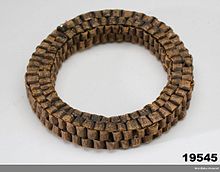

Brewing yeasts may be classed as "top-cropping" (or "top-fermenting") and "bottom-cropping" (or "bottom-fermenting").[56] Top-cropping yeasts are so called because they form a foam at the top of the wort during fermentation. An example of a top-cropping yeast is Saccharomyces cerevisiae, sometimes called an "ale yeast".[57] Bottom-cropping yeasts are typically used to produce lager-type beers, though they can also produce ale-type beers. These yeasts ferment well at low temperatures. An example of bottom-cropping yeast is Saccharomyces pastorianus, formerly known as S. carlsbergensis.
Decades ago,[vague] taxonomists reclassified S. carlsbergensis (uvarum) as a member of S. cerevisiae, noting that the only distinct difference between the two is metabolic. [dubious ] Lager strains of S. cerevisiae secrete an enzyme called melibiase, allowing them to hydrolyse melibiose, a disaccharide, into more fermentable monosaccharides. Top- and bottom-cropping and cold- and warm-fermenting distinctions are largely generalizations used by laypersons to communicate to the general public.[58]
The most common top-cropping brewer's yeast, S. cerevisiae, is the same species as the common baking yeast.
Wine
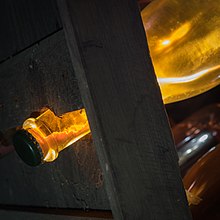
Yeast is used in
Most added wine yeasts are strains of S. cerevisiae, though not all strains of the species are suitable.[67] Different S. cerevisiae yeast strains have differing physiological and fermentative properties, therefore the actual strain of yeast selected can have a direct impact on the finished wine.[68] Significant research has been undertaken into the development of novel wine yeast strains that produce atypical flavour profiles or increased complexity in wines.[69][70]
The growth of some yeasts, such as Zygosaccharomyces and Brettanomyces, in wine can result in wine faults and subsequent spoilage.[71] Brettanomyces produces an array of metabolites when growing in wine, some of which are volatile phenolic compounds. Together, these compounds are often referred to as "Brettanomyces character", and are often described as "antiseptic" or "barnyard" type aromas. Brettanomyces is a significant contributor to wine faults within the wine industry.[72]
Researchers from the University of British Columbia, Canada, have found a new strain of yeast that has reduced amines. The amines in red wine and Chardonnay produce off-flavors and cause headaches and hypertension in some people. About 30% of people are sensitive to biogenic amines, such as histamines.[73]
Baking
This section needs additional citations for verification. (April 2013) |
Yeast, most commonly S. cerevisiae, is used in baking as a

It is not known when yeast was first used to bake bread. The first records that show this use came from Ancient Egypt.[8] Researchers speculate a mixture of flour meal and water was left longer than usual on a warm day and the yeasts that occur in natural contaminants of the flour caused it to ferment before baking. The resulting bread would have been lighter and tastier than the normal flat, hard cake.
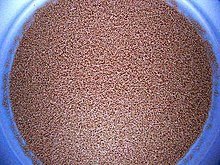
Today, there are several retailers of baker's yeast; one of the earlier developments in North America is Fleischmann's Yeast, in 1868. During World War II, Fleischmann's developed a granulated active dry yeast which did not require refrigeration, had a longer shelf life than fresh yeast, and rose twice as fast. Baker's yeast is also sold as a fresh yeast compressed into a square "cake". This form perishes quickly, so must be used soon after production. A weak solution of water and sugar can be used to determine whether yeast is expired.[75] In the solution, active yeast will foam and bubble as it ferments the sugar into ethanol and carbon dioxide. Some recipes refer to this as proofing the yeast, as it "proves" (tests) the viability of the yeast before the other ingredients are added. When a sourdough starter is used, flour and water are added instead of sugar; this is referred to as proofing the sponge.[citation needed]
When yeast is used for making bread, it is mixed with flour, salt, and warm water or milk. The dough is kneaded until it is smooth, and then left to rise, sometimes until it has doubled in size. The dough is then shaped into loaves. Some bread doughs are knocked back after one rising and left to rise again (this is called dough proofing) and then baked. A longer rising time gives a better flavor, but the yeast can fail to raise the bread in the final stages if it is left for too long initially.
Bioremediation
Some yeasts can find potential application in the field of
Industrial ethanol production
The ability of yeast to convert sugar into ethanol has been harnessed by the biotechnology industry to produce
Saccharomyces yeasts have been
Nonalcoholic beverages
A number of sweet carbonated beverages can be produced by the same methods as beer, except the fermentation is stopped sooner, producing carbon dioxide, but only trace amounts of alcohol, leaving a significant amount of residual sugar in the drink.
- Root beer, originally made by Native Americans, commercialized in the United States by Charles Elmer Hires and especially popular during Prohibition
- Kombucha, a fermented sweetened tea. Yeast in symbiosis with acetic acid bacteria is used in its preparation. Species of yeasts found in the tea can vary, and may include: Brettanomyces bruxellensis, Candida stellata, Schizosaccharomyces pombe, Torulaspora delbrueckii and Zygosaccharomyces bailii.[87] Also popular in Eastern Europe and some former Soviet republics under the name chajnyj grib (Russian: Чайный гриб), which means "tea mushroom".
- Kefir and kumis are made by fermenting milk with yeast and bacteria.[88]
- Mauby (Spanish: mabí), made by fermenting sugar with the wild yeasts naturally present on the bark of the Colubrina elliptica tree, popular in the Caribbean
Foods and nutritional supplements
Yeast is used as an ingredient in foods for its umami flavor, in much of the same way that monosodium glutamate (MSG) is used and, like MSG, often contain free glutamic acid. Examples include:[89]
- Vitam-R (Germany); and Cenovis (Switzerland).
Both types of yeast foods above are rich in
In 1920, the Fleischmann Yeast Company began to promote yeast cakes in a "Yeast for Health" campaign. They initially emphasized yeast as a source of vitamins, good for skin and digestion. Their later advertising claimed a much broader range of health benefits, and was censured as misleading by the Federal Trade Commission. The fad for yeast cakes lasted until the late 1930s.[94]
Probiotics
Some
Aquarium hobby
Yeast is often used by aquarium hobbyists to generate carbon dioxide (CO2) to nourish plants in planted aquaria.[99] CO2 levels from yeast are more difficult to regulate than those from pressurized CO2 systems. However, the low cost of yeast makes it a widely used alternative.[99]
Scientific research
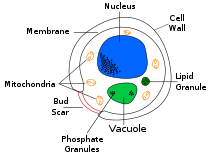
Several yeasts, in particular
On 24 April 1996, S. cerevisiae was announced to be the first eukaryote to have its
Genomic and functional gene annotation of the two major yeast models can be accessed via their respective
Genetically engineered biofactories
Various yeast species have been genetically engineered to efficiently produce various drugs, a technique called
Pathogenic yeasts

Some species of yeast are
Yeasts of the genus has been more recently identified.
Food spoilage
Yeasts are able to grow in foods with a low pH (5.0 or lower) and in the presence of sugars, organic acids, and other easily metabolized carbon sources.
Symbiosis
An Indian study of seven
In another example, Spathaspora passalidarum, found in the digestive tract of bess beetles, aids the digestion of plant cells by fermenting xylose.[124]
Many fruits produce different types of sugars that attract yeasts, which ferment the sugar and turns it into alcohol. Fruit eating mammals find the scent of alcohol attractive as it indicates a ripe, sugary fruit which provides more nutrition. In turn, the mammals helps disperse both the fruit's seeds and the yeast's spores.[125][126]
See also
- Bioaerosol
- Ethanol fermentation
- Evolution of aerobic fermentation
- Kazachstania yasuniensis – a yeast isolated in 2015
- Mycosis(fungal infection in animals)
- Start point (yeast)
- WHI3
- Yeast plasmids
- Zymology
References
- ISBN 978-3-642-55013-3.
The second completely sequenced yeast genome came 6 years later from the fission yeast Schizosaccharomyces pombe, which diverged from S. cerevisiae probably more than 300 million years ago.
- ^ Kurtzman CP, Fell JW (2006). "Yeast Systematics and Phylogeny—Implications of Molecular Identification Methods for Studies in Ecology". Biodiversity and Ecophysiology of Yeasts, The Yeast Handbook. Springer.
- ^ PMID 26447128.
- ISBN 978-3-540-31480-6.
- ISBN 978-3-540-26100-1.
- S2CID 84392827.
- S2CID 39904013.
- ^ S2CID 13157807.
- ^ PMID 10704473.
- ^ "Bioprocess automation". Helsinki University of Technology. 2007. Archived from the original on 7 May 2010. Retrieved 15 January 2012.
- S2CID 44797575.
- ^ "What are yeasts?". Yeast Virtual Library. 13 September 2009. Archived from the original on 26 February 2009. Retrieved 28 November 2009.
- American Heritage Dictionary of the English Language. 2000. Archived from the originalon 6 December 2008. Retrieved 16 November 2008.
- ^ a b Phillips T. "Planets in a bottle: more about yeast". Science@NASA. Retrieved 3 October 2016.
- PMID 31040238.
- ^ Huxley A (1871). "Discourses: Biological & Geological (volume VIII) : Yeast". Collected Essays. Retrieved 28 November 2009.
- ISBN 9780521210133.
- .
- S2CID 34671745.
- S2CID 15986927. Archived from the original(PDF) on 3 March 2019.
- ISBN 978-0-7385-3341-4.
- ^ "Le Comité des Fabricants de levure". COFALEC. Archived from the original on 14 May 2010. Retrieved 21 February 2010.
- ISBN 978-1-57958-380-4.
- ^ Denison, Merrill (1955). The Barley and the Stream: The Molson Story. Toronto: McClelland & Stewart Limited. p. 165.
- PMID 1176959.
- PMID 988016.
- ISBN 978-1-55312-037-7.
- PMID 15912941.
- S2CID 12030027.
- S2CID 239658496.
- ^ PMID 20147331.
- S2CID 8789635.
- S2CID 35231385.
- PMID 17939990.
- S2CID 26625932.
- ^ S2CID 1776642.
- ^ Barley S (10 February 2010). "Stinky flower is kept warm by yeast partner". New Scientist. (subscription required)
- S2CID 28969854.
- PMID 15978000.
- ^ PMID 24738708.This article contains quotations from this source, which is available under a Creative Commons Attribution license.

- ^ S2CID 26625932.
- S2CID 40476719.
- PMID 30108287.
- ^ S2CID 12808612.
- S2CID 25013111.
- PMID 16339736.
- S2CID 44652765.
- PMID 2703462.
- PMID 3070323.
- PMID 20002587.
- ^ S2CID 783720.
- ISBN 978-0306472619.
- PMID 12508902.
- PMID 21179590.

- PMID 22084421.

- ISBN 9781420015171.
- ISBN 978-0-470-28318-9.
- ^ For more on the taxonomical differences, see Dowhanick TM (1999). "Yeast – Strains and Handling Techniques". In McCabe JT (ed.). The Practical Brewer. Master Brewers Association of the Americas.
- ISBN 978-0-471-40546-7.
- ^ a b "Brewer's yeast". University of Maryland Medical Center. Archived from the original on 2 July 2017.
- S2CID 12944068.
- Delft University.
- Elsevier Science: 146–150.)
{{cite journal}}: Cite journal requires|journal=(help - ^ Oelofse A, Pretorius IS, du Toit M (2008). "Significance of Brettanomyces and Dekkera during winemaking: a synoptic review" (PDF). South African Journal of Enology and Viticulture. 29 (2): 128–144.
- ^ Yakobson CM (2010). Pure culture fermentation characteristics of Brettanomyces yeast species and their use in the brewing industry (MSc.). International Centre for Brewing and Distilling, Heriot-Watt University.
- ^ Ross JP (September 1997). "Going wild: wild yeast in winemaking". Wines & Vines. Archived from the original on 5 May 2005. Retrieved 15 January 2012.
- ^ S2CID 7625171.
- PMID 15833139.
- ^ "Research enables yeast supplier to expands options" (PDF). Archived from the original (PDF) on 21 September 2006. Retrieved 10 January 2007.
- S2CID 83723719.
- ^ PMID 12892920.
- ^ Lamar J. "Brettanomyces (Dekkera)". Vincyclopedia. Retrieved 28 November 2009.
- The Vancouver Sun. Archived from the originalon 17 February 2011.
- ISBN 978-0-13-376864-0.
- ^ John (24 August 2023). "Does Yeast Expire? [Active Dry vs Instant Yeast]". PizzaOvensHub. Retrieved 27 September 2023.
- PMID 24780156.
- S2CID 38670765.
- PMID 19467781.
- S2CID 24030739.
- PMID 18065627.

- ISBN 978-0-470-05058-3.
- ^ "Fuel Ethanol Production: GSP Systems Biology Research". Genomic Science Program. U.S. Department of Energy Office of Science. Archived from the original on 3 June 2009. Retrieved 28 November 2009.
- PMID 19218403.
- PMID 9572962.
- S2CID 207467678.
- ISBN 978-0-19-973496-2.
- PMID 15282124.
- PMID 24294220.

- ISBN 978-1-4200-1517-1.
- ^ ISBN 978-1-59253-928-4.
- ^ Lee JG (ed.). "South East Asia Under Japanese Occupation – Harukoe (Haruku)". Children (& Families) of the Far East Prisoners of War. Retrieved 28 November 2009.
- ISSN 2501-0190.
- ISBN 978-0-544-66456-2.
- ^ Price C (Fall 2015). "The healing power of compressed yeast". Distillations Magazine. 1 (3): 17–23. Retrieved 20 March 2018.
- S2CID 40040866.
- PMID 22863358.
- PMID 24106397.

- PMID 20458757.

- ^ a b Pedersen O, Andersen T, Christensen C (2007). "CO2 in planted aquaria" (PDF). The Aquatic Gardener. 20 (3): 24–33. Archived from the original (PDF) on 24 June 2016. Retrieved 29 May 2016.
- PMID 19582228.

- ISBN 978-1-59259-958-5.
- ISBN 978-1-58829-933-8.
- S2CID 35565404.
- ^ Henahan S (24 April 1996). "Complete DNA Sequence of Yeast". Science Updates. Access Excellence. Archived from the original on 5 March 2012. Retrieved 15 January 2012.
- S2CID 4393190.
- ^ Reinert B (1 March 2002). "Schizosaccharomyces pombe: Second yeast genome sequenced". Genome News Network. Archived from the original on 3 May 2008. Retrieved 15 January 2012.
- ISBN 978-3-642-55013-3.
- ^ "About SGD". Saccharomyces Genome Database.
- PMID 22110037.
- ^ "PomBase".
- PMID 30321395.
- PMID 32224264.
- PMID 22136110.

- PMID 23147168.

- PMID 24278784.
- PMID 22763631.

- ^ Deacon J. "The Microbial World: Yeasts and yeast-like fungi". Institute of Cell and Molecular Biology. Archived from the original on 25 September 2006. Retrieved 18 September 2008.
- ^ Hurley R, de Louvois J, Mulhall A (1987). "Yeast as human and animal pathogens". In Rose AH, Harrison JS (eds.). The Yeasts. Volume 1: Biology of Yeasts (2nd ed.). New York, New York: Academic Press. pp. 207–281.
- PMID 23253282.

- ^ ISBN 978-1-85573-966-6.
- ISBN 978-0-9578907-0-1.
- ISBN 978-0-87553-175-5.
- ISBN 978-1-118-52267-7.
- PMID 17011177.
- ^ Yirka, Bob (20 July 2023). "Wild fruits with higher alcohol content found to be more widely dispersed by mammals". Phys.org. Archived from the original on 8 March 2024.
- ^ Sagar, Soumya (19 July 2023). "Alcoholic fruit may help plants recruit mammals to spread their seeds". New Scientist. Archived from the original on 8 March 2024.
Further reading
- Alexopoulos CJ, Mims CW, Blackwell M (1996). Introductory Mycology. New York: Wiley. ISBN 978-0-471-52229-4.
- Kirk PM, Cannon PF, Minter DW, Stalpers JA (2008). Dictionary of the Fungi (10th ed.). Wallingford, UK: CAB International. ISBN 978-0-85199-826-8.
- Kurtzman CP; Fell JW; Boekhout T, eds. (2011). The Yeasts: A Taxonomic Study. Vol. 1 (5th ed.). Amsterdam, etc.: Elsevier. ISBN 978-0-12-384708-9.
- Money, Nicholas P. (2018). The Rise of Yeast: How the Sugar Fungus Shaped Civilisation. Oxford University Press. ISBN 978-0198749707.
- Priest FG, Stewart GG (2006). Handbook of Brewing (2nd ed.). CRC Press. p. 691. ISBN 978-1-4200-1517-1.
External links
- Saccharomyces genome database
- Yeast growth and the cell cycle (archived 21 July 2007)
- Yeast virtual library

